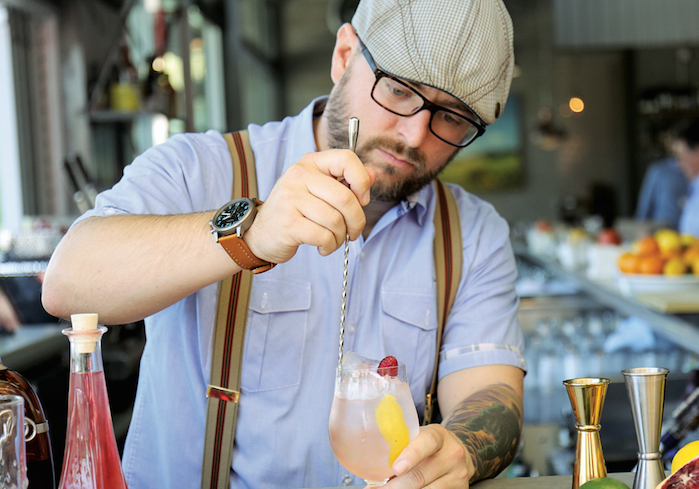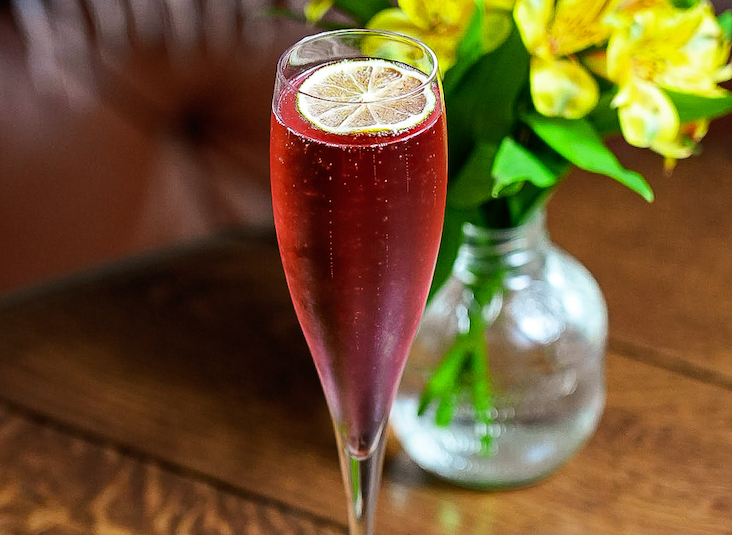As beverage director for the Fox Restaurant Concepts, Mat Snapp oversees a diverse portfolio of drinks programs. The Phoenix, AZ-based company includes 54 restaurants spread across 16 concepts and 13 states.
How different are these brands? They range from the healthy (True Food Kitchen, Flower Child, Juby True) to the meaty (The Arrogant Butcher, Zinburger) to the intimate (Little Cleo’s Seafood Legend) and the cool (Culinary Dropout,). Cuisines span from Italy (North Italia) to Mexico (Blanco Tacos + Tequila) to California/American (The Greene House, Wildflower, The Henry), not to mention rotisserie chicken and pizza (Doughbird).
A few concepts are one-off locations, such as Little Cleo’s, The Henry and Wildflower; others are growing chains spread across the country, such as True Food (17 units) and North Italia (9 locations).
Some deal with rapid guest turnover, such as the Culinary Dropout location in the Las Vegas Hard Rock Hotel & Casino, while others are neighborhood restaurants with loyal local followings.
Complicating Snapp’s responsibilities is that these brands change menus two to five times a year. So how does he create and manage beverage programs for each concept?
“You have to understand who each brand is, what’s their soul, feeling and personality,” explains Snap (pictured atop). “It means allowing yourself to wear a lot of different clothes.”

Cocktails at North Italia, from left: Sicilian Margarita topped with sangria, Dimmi Bravo with raspberry limoncello, and Apple Bourbon Punch, with vanilla, apple, bourbon and chai.
Crafty Beverages
Drink development for any of the concepts always starts with ingredients, Snapp says. “Each season I end up with a few new favorites and try to have a dozen or so different ways to use them.”
Some seasons it’s an amaro that Snapp is intrigued with, sometimes it’s a specific liqueur or whiskey. “I came across Bitterman’s Hopped Grapefruit bitters one year and had to refrain from putting it on every menu in the company,” he notes.
Once Snapp has a few great ingredients in hand, he works towards the menu. Each concept menu has a shape: Culinary Dropout “needs to be powerful but not confusing, geeky but still inclusive,” he notes. “North [Italia] needs to make drinking beautiful and balanced, strength through composition instead of spirit, and so on.”
When it comes to developing new cocktails, Snapp and his team will spend a few days brainstorming, testing and compiling ideas before holding creative meetings. Most of the drink ideas do not work, Snap admits, but that’s key to the process. The team home in on what tastes great and fits into the brands’ themes—and then figure out how to scale it. Snapp says that he is mindful of cost through the whole process. “But in creative development, you need a finished and enviable product first—each menu has a few cocktails that are more expensive to execute and some that are less expensive.”
The trick isn’t hiding your financial decisions, he notes, “it’s making all your cocktail decisions taste as great as they should.”

The Chamomile Cooler at True Food Kitchen blends chamomile-infused gin, diced orange, lemon juice and honey syrup.
What are some of the recent cocktail innovations at Fox Restaurant Concepts? True Food Kitchen’s Chamomile Cooler ($10), blends chamomile-infused gin, diced orange, lemon juice and honey syrup. The Henry’s list includes Czech The Gate, made with Redemption rye whiskey, Becharovka, pear liqueur and lemon; and Southern City Mischief, with brown butter Bulleit bourbon, orange marmalade and lemon (both $12).
Culinary Dropout’s menu boasts the Drunken Panda, with cucumber sake, white tea syrup, calamansi citrus fruit, Lucky Buddha lager; and Pistols At Dawn, with Bulleit bourbon, Ancho Reyes chile liqueur, ginger agave, cabernet splash (both $11). And North Italia offers several cocktails, such as the Rosemary & Lime (Ketel One vodka, Amaro Nonino, rosemary, Angostura bitters and smashed lime), that can be ordered as a single drink ($11) or a pitcher ($36).
A Discovery Process
When Snapp looks for new beverage products, he focuses on several aspects: story and name; taste, balance and quality; price and ease of use.
To spot a good story, Snapp keeps an eye out for “the little guy who is about to become the next medium guy.” He believes in the mantra that when you see it, you know it.
Snapp is always searching for that next small-batch product that can surprise customers. This quest recently took him to Montana for Whitefish Handcrafted Spirits, a distillery and restaurant. He sampled cocktails made with Whitefish spirits and was so impressed that he’s now working on incorporating the brand into Fox menus.
“I might be the first person to take Whitefish out of Montana,” he says. “It’s kind of our duty as the big guy to be finding and telling these stories.”
Snapp takes pride when a Fox restaurant is the first business in a state or market to carry a new product. “Nothing feels better than planting that flag,” he says. “And it allows us to get ahead of that storm before it blows up and becomes trendy. People remember that.”

Culinary Dropout cocktails include the Drunken Panda with cucumber sake, white tea syrup, calamansi and Lucky Buddha lager.
Regan Jasper, vice president of beverage and partner in Fox Restaurant Concepts, is the corporate sommelier and Snapp’s boss. He handles all wine placements and education. “He loves shining a bright light on a small-production wine just as much as he loves taking a great name with a solid reputation and selling a thousand cases of it,” Snapp says of Jasper. “We are so lucky to be able to do both because our concepts are so diverse, our bandwidth so wide, and our audience so excited.”
A recent discovery was Jamey Whetstone, a “surfer dude turned winemaker” who opened Whetstone Cellars in Napa four years ago. Whetstone’s story appealed to Snapp and Jasper, who incorporated the brand into Fox’s wine buying. This helped the new vineyard grow from 2,000 to 3,000 cases a year to ten times that number.
It’s not always easy to be the first to bring a product to market. Snapp recently discovered an Italian fig vodka called Figenza that he wanted to bring into the Texas locations. Despite multiple attempts, he could not convince suppliers there to carry the spirit, so he changed the menu and moved on.
The other challenge is that you can’t carry everything. With beer, for instance, it’s important to offer all kinds—balanced and bold, classic and comfortable, new and exciting, Snapp says. But when it comes to adding new brands, “I say no a lot, like almost 100% of the time.”
Prep Hard, Live Easy
When it comes to training, especially for new staff at new locations, Fox Restaurants Concepts operates under the motto: “Prep hard and live easy.”
The idea is to backload the hard work so that staff is never seen struggling in front of a guest. They don’t waste valuable time during peak hours on intensive production methods if preparations are done in advance.
“If you want to put hibiscus into a cocktail, then we’ll figure out a way to make a hibiscus liqueur with a 48-hour shelf life so that you can still make the drinks quickly and consistently,” Snapp says. “We’ll figure out the recipe down to the gram, making it as easy to bottle as any recipe from the kitchen.”

The Little Hot, Little Dirty is a dirty vodka Martini with Calabrian chili.
Fox’s latest concept, Doughbird Pizza & Rotisserie, launched in March and serves pitchers of beer, carafes of wine, and easy summer cocktails. For instance, the ingredients for its Raven and Geary Margarita are prepared in advance to make execution easy, Snapp says.
“We blend three tequilas and soak them for 24 hours on orange and lime rinds to extract orange and lime oils,” he explains. “This negates the need for a sugary triple sec or expensive curaçao to be used.”
The house sour mix is made daily with fresh-squeezed lemon and lime juices, cane-sugar syrup, yuzu and clover honey. When a guest orders the Margarita, a simple 2 parts to 3 parts recipe gets the drink into their hands in less than a minute, Snapp says.
Immersive Education
Fox Restaurant Concepts founder Sam Fox opened his first restaurant, Wildflower, in 1998 in Tuscon, AZ, at the age of 20. The son of restaurateurs, Fox funded the venture by dropping out of college and investing his remaining tuition money.
The company today employs more than 5,000 people throughout the U.S. It’s constantly growing and has expanded beyond Arizona into California, Texas and other major metro areas.
Snapp joined Fox in 2004 as a server for the first North Italia location. Then he “wandered and traveled” for a bit and earned his Somm 1 and other beverage certifications before returning in 2008. He began working closely with Jasper on a “serious growth schedule.”
Snapp recalls in 2012 when Fox Restaurants was conceptualizing the American cuisine brand The Arrogant Butcher. Jasper and Fox sent Snapp and a chef to Las Vegas to check out the similarly themed Hash House A Go Go chain.

Subtle Menace cocktail at Little Cleo’s Seafood Legend, made with a gin, absinthe, sauvignon blanc and lime.
“They flew me down there and told me to order the whole menu,” Snapp laughs. This strategy works well with employees as it builds “that one moment of cohesion when it all of a sudden all makes sense to them,” he explains. It’s a tactic he uses frequently with his team.
Snapp recalls a recent conversation with a 20-year-old employee at one of the restaurants. The worker wanted to know more about coffee, which the location specialized in.
“He was very excited,” Snapp explains. “So I pulled some cash out of petty and sent it to him and said, ‘Try all the coffees in your area’.”
He instructed the staffer to take a few days to sample the coffees, write down what he thought about each one, and then report back with his findings. “That’s about the best $100 you can ever spend on an employee,” Snapp says. “It gets him in tune with what he needs to know.”
In another example, a wine was underperforming at one location. Snapp asked the unit’s beverage manager what he thought about the taste of the struggling wine, but the employee couldn’t say, as he was not familiar with its flavors.
Snapp instructed the manager to take three bottles and hold a staff tasting. In the weeks and months that followed, sales climbed for the wine.
While visiting a location, Snapp might spring open a bottle of wine, taste with the staff, and discuss the best ways to pair with it. “I don’t subscribe to the boilerplate way of training in most restaurants,” he says, “except when we’re opening a place totally new.”

“You have to understand who each brand is, what’s their soul, feeling and personality. It means allowing yourself to wear a lot of different clothes.” — Mat Snapp, beverage director for the Fox Restaurant Concepts
Keeping In Touch
Snapp keeps in close contact with Fox’s beverage managers and buyers. “Basically any of our brands with over 30% of their business as beverage, I’m on a first-name basis with their manager and buyer,” he says.
Snapp communicates with the team constantly via group texts, which allow him to reach everybody immediately. Promptness is beneficial, he explains, in case he sees that the price for a liqueur has dropped online and he wants everyone to stock up. Or if a buyer wants to know the best price to pay for a certain pinot grigio.
A quick text will field an array of answers from a variety of professionals at different brands. “I’m always monitoring those conversations of like-minded professionals who are educating each other based on the routines that I set down,” Snapp says.
To ensure the quality and consistency of its products and service, the whole staff undergoes a week of intensive training before they open a location. This involves tasting everything on the menu. Fox also works with Coyle Hospitality, which provides mystery-shopping services for hotels, restaurants and cruise lines.
But training and empowerment can only do so much: you have to hire the right people. “We subscribe to a very serious version of hospitality: We are unwilling to lose the loyalty of a single guest,” Snapp notes. “And what that has taught me is that you cannot teach people to be nice.”
But you can teach nice people the fine details of hospitality. “Someone who wants to work hard and be helpful and nice—they can learn how to order beverages to budget” and make drinks, Snapp says. “But if you cannot convince them to stop yelling at their chef over something as small as cherries not being fresh, then you’re wasting your time.”
Kyle Swartz is managing editor of Cheers magazine. Reach him at kswartz@epgmediallc.com or on Twitter @kswartzz.







